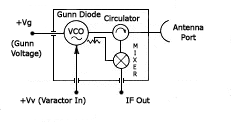Microwave Communications


Have you ever worked a band above 440? Probably not. With the exception of 1296 MHz, I am not aware
of any commercially made ham transceivers available for bands above 440. There are many homebrew
devices and kits available, but only ICOM and Kenwood ever produced commercial type accepted transceivers
for these bands, limited to one model each. These are the last frontiers of the amateur radio homebrew community, where
the pioneer spirit still reigns!
The Start!


I have been interested in these frequencies from long before I was a licensed ham. I built a downconvertor for
1296 back in the early eighties to listen to the then proposed 1296 beacon on an Oscar bird. The downconvertor was
based on a design I originally found in the ARRL Handbook. It used an interdigital filter/mixer combination with a Schottky
diode for the active element in the mixer. The receiver was a shortwave receive tuned in the 10M band. The LO chain was hard
to get working with my limited resources and I was never really sure it was working right, but I could hear lots of signals,
mainly beacons (I think) from aircraft on the nearby airbase and control links. Never heard any ham activity at the time, though.
I later became licensed and discovered that there are extremely few hams in this area with the interest, much less station
capabilities to work above 440. There was some activity on 2M and 432 sideband, but nothing serious. There has been a
revived interest in these bands lately and I'm hoping to exploit that.
GunnPlexers


Once upon a time I decided I would build some 10 GHz stations. This started when a couple of X-Band GunnPlexers ended up in my hands.
These are magnificent devices, available from Advance Receiver Research, which functions as a sort of "all-in-one" RF head for microwave work.
 |
 |
| Figure 1 - GunnPlexers |
Figure 2 - GunnPlexer Block Diagram |
I have considered injecting a crystal controlled signal into the cavity to acheive a "sympathy lock" effect, but have never gotten
around to it. My idea is to use a surplus PC clock crystal at 50 MHz blasting away on the varactor diode, since the 205th harmonic of 50 MHz falls on 10.25 GHz.
According to the technical books, only a little signal (20 to 30 db down from the Gunn power level) is required to achieve lock. This technique might yield some
interesting results if I don't destroy the varactor in the process.
Another interesting project is to use the GunnPlexers as data transceivers. With the wide band nature of data transmissions, the drift of a GP module is of little consequence.
What drift is present can be compensated for with standard AFC loops. Here
is an example of such a project.
Narrow Band 10 GHz


Section on Narrow band stuff, write up on Didier's efforts.
Linear Transvertors


Write about linear transvertors!
Antennas


Antennas for microwave bands can be built or scrounged. Horns are the most common antenna structure found in microwave use. Horns
can be bought commercially, or can be constructed from various materials such as sheet brass, copper or copper-clad pc board. Dishes can be
employed at frequencies as low as 2400 without becoming to unwieldy. They are particularly effective above 5 GHz, where thier small size can
contribute a large gain, especially in concert with a horn feed. Dish feeds can be constucted from various scrap materials as well, a common
feed being printed on circuit board material. For satellite work, helical feeds sued with surplus Direct-TV dishes can be employed
with great success. Here is a great ham opriented dish site!
Summary


Links



